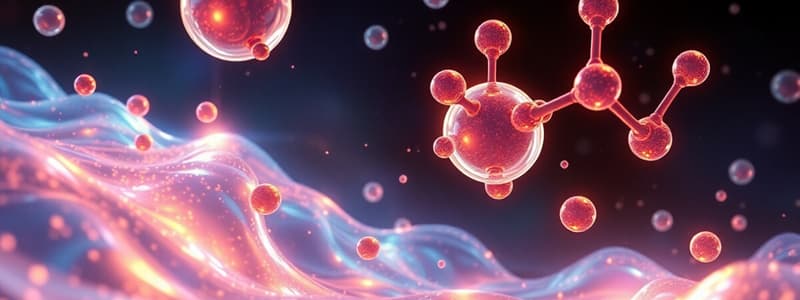Podcast
Questions and Answers
Flashcards
Kinetic Molecular Theory
Kinetic Molecular Theory
The theory explaining the behavior of particles in solids and liquids based on their motion and interactions.
Intermolecular Forces
Intermolecular Forces
Forces between molecules that affect physical properties like boiling and melting points.
Dipole-Dipole Forces
Dipole-Dipole Forces
Attractive forces between polar molecules due to their positive and negative ends.
Hydrogen Bonding
Hydrogen Bonding
Signup and view all the flashcards
Viscosity
Viscosity
Signup and view all the flashcards
Boiling Point
Boiling Point
Signup and view all the flashcards
Colligative Properties
Colligative Properties
Signup and view all the flashcards
Density
Density
Signup and view all the flashcards
Phase Diagrams
Phase Diagrams
Signup and view all the flashcards
Heating Curve
Heating Curve
Signup and view all the flashcards
Cooling Curve
Cooling Curve
Signup and view all the flashcards
Mole Fraction
Mole Fraction
Signup and view all the flashcards
Osmotic Pressure
Osmotic Pressure
Signup and view all the flashcards
First Law of Thermodynamics
First Law of Thermodynamics
Signup and view all the flashcards
Activation Energy
Activation Energy
Signup and view all the flashcards
Collision Theory
Collision Theory
Signup and view all the flashcards
Catalysts
Catalysts
Signup and view all the flashcards
Homogeneous Catalysts
Homogeneous Catalysts
Signup and view all the flashcards
Heterogeneous Catalysts
Heterogeneous Catalysts
Signup and view all the flashcards
Enthalpy Change
Enthalpy Change
Signup and view all the flashcards
Internal Energy Change
Internal Energy Change
Signup and view all the flashcards
Freezing Point Depression
Freezing Point Depression
Signup and view all the flashcards
Boiling Point Elevation
Boiling Point Elevation
Signup and view all the flashcards
Equilibrium Position
Equilibrium Position
Signup and view all the flashcards
Thermodynamic Systems
Thermodynamic Systems
Signup and view all the flashcards
Chemical Kinetics
Chemical Kinetics
Signup and view all the flashcards
Energy Barrier
Energy Barrier
Signup and view all the flashcards
Study Notes
Review Materials in General Chemistry 2 (Second Semester)
- Liquids, Solids, and Gases (KMT): Liquids have a stronger attractive force among particles than gases, causing them to be closer together. Compared to solids, liquids have weaker attractive forces.
Dipole-dipole Forces vs. Hydrogen Bonding
- Dipole-Dipole Forces: A force that occurs between polar molecules, where the positive end of one molecule is close to the negative end of another. This interaction depends on the molecular shape and includes nonpolar substances that can be condensed into liquid or solid.
- Hydrogen Bonding: A stronger dipole-dipole force that involves an attraction between a hydrogen atom bonded to a highly electronegative atom (F, O, or N) and an unshared electron pair on another electronegative atom.
Intermolecular Forces and Viscosity
- Intermolecular Forces and Viscosity: The stronger the intermolecular forces, the more viscous the liquid. The smaller the molecules, the less viscous the liquid. The higher the temperature, the lower the viscosity. A liquid with stronger intermolecular forces will form smaller, spherical droplets on a surface whereas weaker intermolecular forces cause the liquid to spread out more. Furthermore a liquid with stronger intermolecular forces will have a higher boiling point and evaporate slower than a liquid with weaker forces.
Properties of Water
- Water's Properties: Water's high boiling point, resulting from strong hydrogen bonding, is the main reason it remains liquid at room temperature. The density of liquid water is greater than the density of solid water (ice).
Phase Transitions of Water and Carbon Dioxide
- Phase Transition Interpretation: When pressure increases, water (which is a liquid at room temperature) has a phase transition when pressure increases. Water transitions from a gaseous state to a solid state, when pressure increases. Carbon dioxide (which is in a solid state at 80 C) transitions to a gaseous state, only when pressure increases.
Cooling Curve of a Substance
- Cooling Curve: Liquids can be cooled below normal freezing points before freezing. The freezing point remains constant during a phase change.
Solution and Mole Fraction
- Mole Fraction: Given the mass of solute (NaOH) in g and mass of water in g, and the volume of the solution in mL, determine the mole fraction for NaOH.
Percent by Mass
- Calculate Percent by Mass: To find percent by mass, use the mass of the solute divided by the total mass of the solution (solute plus solvent), then multiply by 100.
Freezing Point
- Freezing Points: The freezing point of a solution is affected by the solute added within it.
Osmotic Pressure and Molar Mass
- Osmotic Pressure: Osmotic pressure depends on the molar mass of the sample. When the molar mass is calculated, ensure that significant figures are used in the final answer.
Homogeneous vs Heterogeneous Catalysts
- Homogeneous vs Heterogeneous Catalysts: Homogeneous catalysts interact uniformly with reactants, compared to heterogeneous catalysts' targeted interaction with reactants
- Catalyst Role: Catalysts provide an alternative reaction pathway with lower activation energy, thus increasing the rate of a reaction.
Zero-Order vs First-Order Reactions
- Zero-Order vs First-Order Reactions: Zero-Order reactions do not depend on the concentration of the reactants whereas First-Order reactions depend on the concentration of one reactant.
Studying That Suits You
Use AI to generate personalized quizzes and flashcards to suit your learning preferences.
Related Documents
Description
Test your understanding of intermolecular forces in liquids, solids, and gases with this quiz. Explore concepts like dipole-dipole forces, hydrogen bonding, and their effects on viscosity. Suitable for students in the second semester of General Chemistry.




